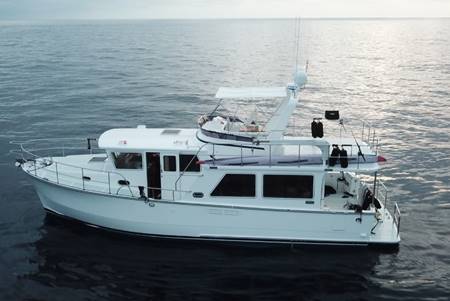Helmsman 43 - Seakeeper Gyro Experience
By Bill Fletcher
My wife and I took delivery of our Helmsman 43 in May 2018. Prior to ordering the boat, I did some basic research on the available stabilization systems. We have never had stabilization on our past boats, so this was a new topic for me. There are quite a few articles from long range cruisers who use active fins, and the owners appear to be very happy with their performance. Personally, I did not want to have anything protruding from the hull for various reasons.

I have read articles regarding Gyroscopic Stabilization systems and have spoken to people who used them. I also connected with others on boating forums to hear about their experiences. Our boating consists of day trips off shore and coastal cruising, so the need to run a generator to power the Gyro was not a concern. After reviewing the available options, I felt the Gyro was the best approach for our needs based on our current, and planned boat usage when we retire.
I talked to Scott Helker while the boat was still in the early construction phase, and he put me in touch with a technical representative from Seakeeper. Seakeeper provided modeling for three of their units; The 5, 6, and 9 Series Gyros. The SK 9 would provide the most dampening; however the cost was almost 3X the SK5. I was also concerned about the extra weight of the SK9 unit. We ended up ordering the SK5 due to the lower cost and weight, and one was available for the build which would not impact the schedule.

People often ask me “how much roll reduction does it provide”. There are a lot of factors to consider including the sea state and wave period. The table below is my very unscientific estimate of the roll reduction for various conditions based on a forward quartering sea. The aft quartering sea performance (180 degree course change) is fairly similar. I used this swell direction as an example because these are the predominate sea conditions when heading up and down the coast of Southern California.
Swell Ht. (Ft.) | Roll Reduction |
1 | 90% |
2 | 80% |
3 | 60% |
4 | 50% |
5 | 30% |
As previously noted, my roll reduction estimates are for the SK5 unit which is no longer produced. The next Gen SK6 would provide a slight gain in roll reduction because it has a 20% higher torque rating.
We specified the boat with a Cummins/Onan 9KW Generator. This lower RPM generator is very quiet, which is nice for longer runs. When the Gyro and Generator are running, the noise level is very low and is barely discernable over the engine. Overall, the sound insulation on the boat for the engine compartment is excellent. When the Gyro is off, it takes a few hours for it to spool down and it produces a very light humming sound.
There are two zincs on the raw water cooling system. After 7 months and 150 hours on the Gyro the burn rate was about 30% as seen in the picture below. For our conditions in So-Cal, changing these every 6 months will be sufficient. The main cover plate needs to be removed to gain access to these. The aft zinc is somewhat difficult to remove, but once a wrench is on the zinc head, it comes out easy enough.

Preventive Maintenance (PM) on these units should be done by a factory trained Seakeeper Technician. They will run all year without any fuss, but they are complex systems. The Seakeeper PM Schedule contains the recommended PM’s. The Seakeeper Corporate Office and the local Technician in our area have been very supportive throughout this process.
Overall, my wife and I are very happy with the system and feel it was well worth the investment. Whether it’s a day cruise in the Harbor, or heading offshore, the reduction in rolling makes things more pleasant in general.
